Business Law Assignment: Contract Law and Business Structures 2017
VerifiedAdded on 2020/05/11
|16
|3809
|82
Homework Assignment
AI Summary
This business law assignment analyzes two main tasks. Task 1 evaluates whether brothers should form a partnership or a company, comparing their advantages and disadvantages, especially concerning liability, capital, and regulation, recommending a partnership structure. Task 2 examines several contract law issues: whether a store must honor an advertised price (invitation to treat vs. offer), whether a couple legally owned a bed (revocation of offer), whether a party can sue for breach of contract (lack of intention), and the impact of death or mental illness on a contract (separate legal entity and contractual capacity).

Paraphrase This Document
Need a fresh take? Get an instant paraphrase of this document with our AI Paraphraser

CONTRACT LAW 2
Task 1
Issue
Whether the brothers should opt for a partnership form of business, or whether they should
incorporate a company form of business structure. Trust form of business structure is opted
majorly for taxation benefit purpose and so, the focus of this discussion is not on it.
Rule
In Australia, broadly there are four business forms in which the person can run their business.
These four are partnership, sole trader, trust and company. Every business structure is coupled
with its own advantages and disadvantages and the choice of selecting a particular business
structure depends on these features only. A sole trader has the option of converting their trade
into partnership or company (Gibson and Fraser, 2013).
In a partnership form of business structure, two or more individuals, come together for carrying
on a business with common objectives, with the aim of sharing profits equally. Every Australian
state has its own Partnership Act and on the basis of the state in which the partnership is, the
relevant partnership act applies. For instance, in the Partnership Act, 1895 is applied in WA and
Partnership Act, 1891 is applicable in SA (Department of Industry, Innovation and Science,
2017). The advantages and disadvantages of partnership form of business structure have been
properly covered in the below mentioned table.
Advantages Disadvantages
Task 1
Issue
Whether the brothers should opt for a partnership form of business, or whether they should
incorporate a company form of business structure. Trust form of business structure is opted
majorly for taxation benefit purpose and so, the focus of this discussion is not on it.
Rule
In Australia, broadly there are four business forms in which the person can run their business.
These four are partnership, sole trader, trust and company. Every business structure is coupled
with its own advantages and disadvantages and the choice of selecting a particular business
structure depends on these features only. A sole trader has the option of converting their trade
into partnership or company (Gibson and Fraser, 2013).
In a partnership form of business structure, two or more individuals, come together for carrying
on a business with common objectives, with the aim of sharing profits equally. Every Australian
state has its own Partnership Act and on the basis of the state in which the partnership is, the
relevant partnership act applies. For instance, in the Partnership Act, 1895 is applied in WA and
Partnership Act, 1891 is applicable in SA (Department of Industry, Innovation and Science,
2017). The advantages and disadvantages of partnership form of business structure have been
properly covered in the below mentioned table.
Advantages Disadvantages

CONTRACT LAW 3
The partnership form of business structure has
very low starting costs in comparison to other
form of business structures, particularly
company.
The biggest drawback of a partnership is that it
has an unlimited liability. This means that
when the debts of the partnership are not
fulfilled through the partnership, the personal
property of the partners can be attached to
discharge the debts of the partnership. This is
because, unless the partnership deed states
otherwise, the partners of the firm are severally
and jointly liable for the debts of the firm.
When there are high number partners in a firm,
the skill set of the firm is widened as each
partner brings a unique skill with them.
When there is a disagreement in between the
partners, it can result in the dissolution of the
partnership, particularly when the same is not
resolved.
When a partnership is compared to sole trader,
higher capital can be brought in the business.
The partners are deemed as the agent of the
firm, and the acts of partners bound each other.
The partners have separate borrowing capacity
and the same increases the borrowing capacity
of the partnership firm.
The partnership comes to an end, with the
partner’s death.
The employees, who have proved themselves,
can easily be made a part of the firm, by
Each time a partner is added or removed from
the firm; there is a need to revalue the firm and
The partnership form of business structure has
very low starting costs in comparison to other
form of business structures, particularly
company.
The biggest drawback of a partnership is that it
has an unlimited liability. This means that
when the debts of the partnership are not
fulfilled through the partnership, the personal
property of the partners can be attached to
discharge the debts of the partnership. This is
because, unless the partnership deed states
otherwise, the partners of the firm are severally
and jointly liable for the debts of the firm.
When there are high number partners in a firm,
the skill set of the firm is widened as each
partner brings a unique skill with them.
When there is a disagreement in between the
partners, it can result in the dissolution of the
partnership, particularly when the same is not
resolved.
When a partnership is compared to sole trader,
higher capital can be brought in the business.
The partners are deemed as the agent of the
firm, and the acts of partners bound each other.
The partners have separate borrowing capacity
and the same increases the borrowing capacity
of the partnership firm.
The partnership comes to an end, with the
partner’s death.
The employees, who have proved themselves,
can easily be made a part of the firm, by
Each time a partner is added or removed from
the firm; there is a need to revalue the firm and
⊘ This is a preview!⊘
Do you want full access?
Subscribe today to unlock all pages.

Trusted by 1+ million students worldwide
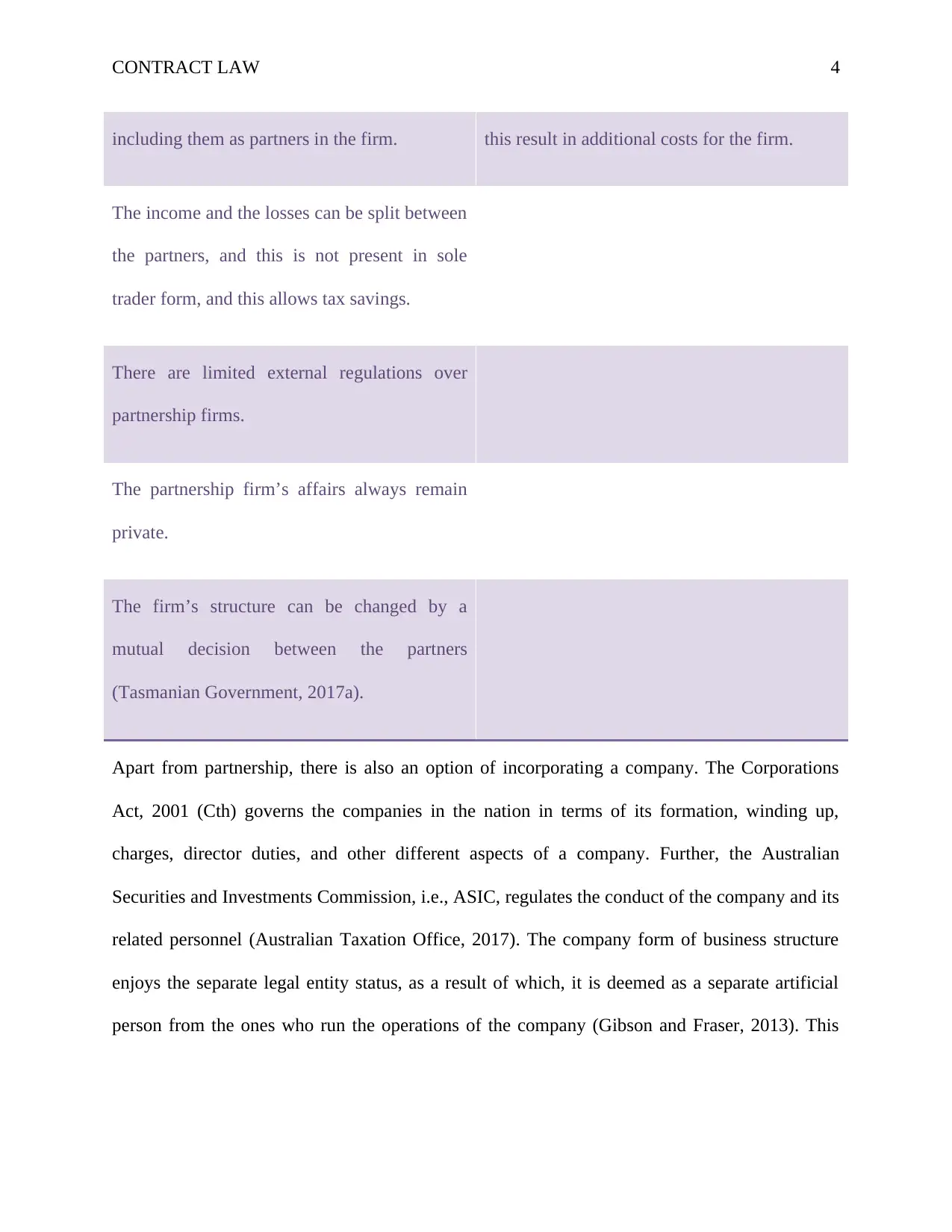
CONTRACT LAW 4
including them as partners in the firm. this result in additional costs for the firm.
The income and the losses can be split between
the partners, and this is not present in sole
trader form, and this allows tax savings.
There are limited external regulations over
partnership firms.
The partnership firm’s affairs always remain
private.
The firm’s structure can be changed by a
mutual decision between the partners
(Tasmanian Government, 2017a).
Apart from partnership, there is also an option of incorporating a company. The Corporations
Act, 2001 (Cth) governs the companies in the nation in terms of its formation, winding up,
charges, director duties, and other different aspects of a company. Further, the Australian
Securities and Investments Commission, i.e., ASIC, regulates the conduct of the company and its
related personnel (Australian Taxation Office, 2017). The company form of business structure
enjoys the separate legal entity status, as a result of which, it is deemed as a separate artificial
person from the ones who run the operations of the company (Gibson and Fraser, 2013). This
including them as partners in the firm. this result in additional costs for the firm.
The income and the losses can be split between
the partners, and this is not present in sole
trader form, and this allows tax savings.
There are limited external regulations over
partnership firms.
The partnership firm’s affairs always remain
private.
The firm’s structure can be changed by a
mutual decision between the partners
(Tasmanian Government, 2017a).
Apart from partnership, there is also an option of incorporating a company. The Corporations
Act, 2001 (Cth) governs the companies in the nation in terms of its formation, winding up,
charges, director duties, and other different aspects of a company. Further, the Australian
Securities and Investments Commission, i.e., ASIC, regulates the conduct of the company and its
related personnel (Australian Taxation Office, 2017). The company form of business structure
enjoys the separate legal entity status, as a result of which, it is deemed as a separate artificial
person from the ones who run the operations of the company (Gibson and Fraser, 2013). This
Paraphrase This Document
Need a fresh take? Get an instant paraphrase of this document with our AI Paraphraser

CONTRACT LAW 5
form also has a number of advantages and disadvantages which have been properly covered in
the below mentioned table.
Advantages Disadvantages
The liability of the shareholders is limited in
company, as against that of partners in
partnership firm.
The company form of business structure is a
costly choice, as the costs of its formation and
winding up are quite high.
The ownership can be transferred easily by
simply selling the shares to another.
The company form has to abide by a range of
compliances.
The employees can be the shareholder of the
company.
The affairs of any company are deemed as a
public matter.
There is a uniform piece of legislation which
applies on company form of business structure,
unlike the state based partnership acts.
There is also an applicability of tax on the
distributable profit.
The rates of taxation are favourable for
companies.
Where there is a failure of directors in fulfilling
their duties covered under the governing act,
they can be held liable in a personal manner.
form also has a number of advantages and disadvantages which have been properly covered in
the below mentioned table.
Advantages Disadvantages
The liability of the shareholders is limited in
company, as against that of partners in
partnership firm.
The company form of business structure is a
costly choice, as the costs of its formation and
winding up are quite high.
The ownership can be transferred easily by
simply selling the shares to another.
The company form has to abide by a range of
compliances.
The employees can be the shareholder of the
company.
The affairs of any company are deemed as a
public matter.
There is a uniform piece of legislation which
applies on company form of business structure,
unlike the state based partnership acts.
There is also an applicability of tax on the
distributable profit.
The rates of taxation are favourable for
companies.
Where there is a failure of directors in fulfilling
their duties covered under the governing act,
they can be held liable in a personal manner.
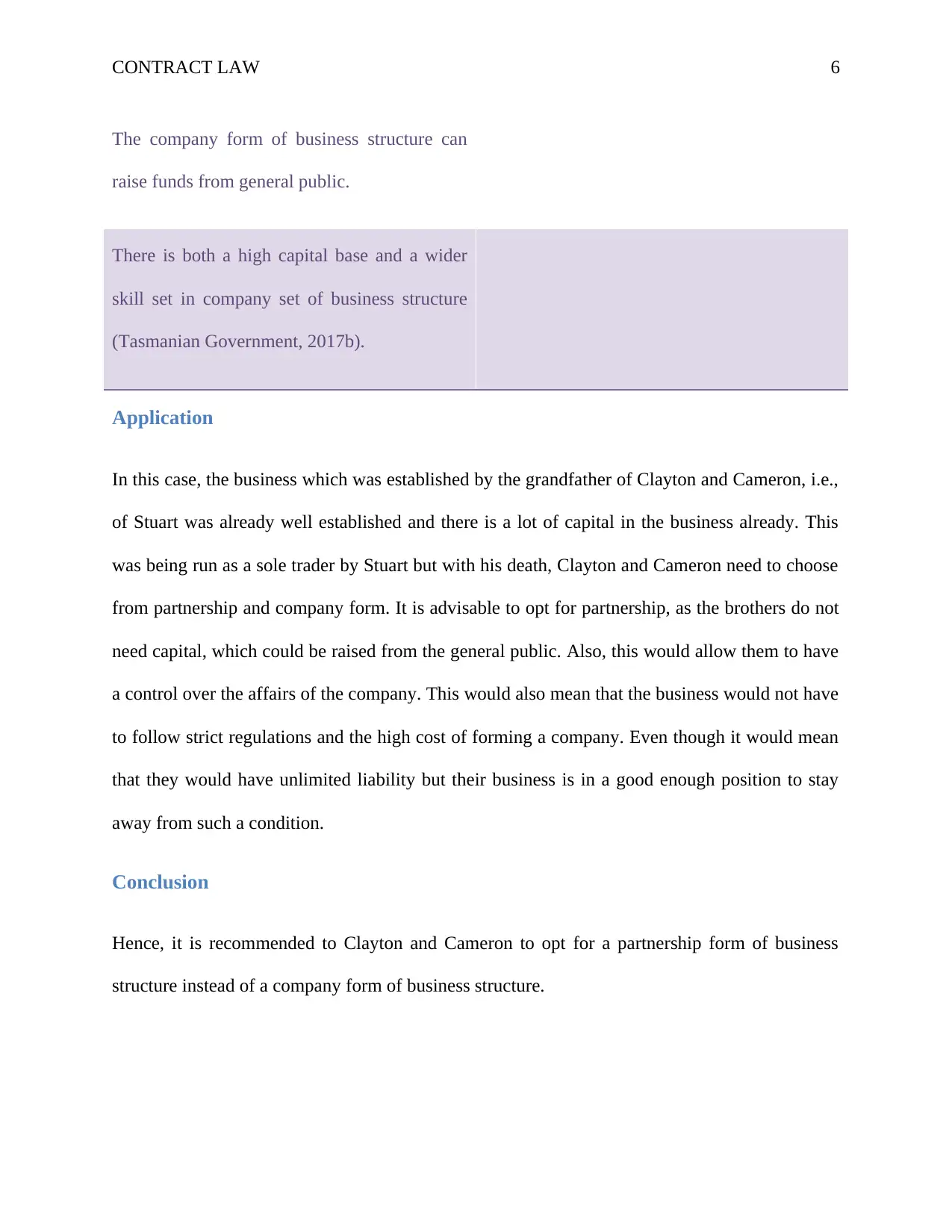
CONTRACT LAW 6
The company form of business structure can
raise funds from general public.
There is both a high capital base and a wider
skill set in company set of business structure
(Tasmanian Government, 2017b).
Application
In this case, the business which was established by the grandfather of Clayton and Cameron, i.e.,
of Stuart was already well established and there is a lot of capital in the business already. This
was being run as a sole trader by Stuart but with his death, Clayton and Cameron need to choose
from partnership and company form. It is advisable to opt for partnership, as the brothers do not
need capital, which could be raised from the general public. Also, this would allow them to have
a control over the affairs of the company. This would also mean that the business would not have
to follow strict regulations and the high cost of forming a company. Even though it would mean
that they would have unlimited liability but their business is in a good enough position to stay
away from such a condition.
Conclusion
Hence, it is recommended to Clayton and Cameron to opt for a partnership form of business
structure instead of a company form of business structure.
The company form of business structure can
raise funds from general public.
There is both a high capital base and a wider
skill set in company set of business structure
(Tasmanian Government, 2017b).
Application
In this case, the business which was established by the grandfather of Clayton and Cameron, i.e.,
of Stuart was already well established and there is a lot of capital in the business already. This
was being run as a sole trader by Stuart but with his death, Clayton and Cameron need to choose
from partnership and company form. It is advisable to opt for partnership, as the brothers do not
need capital, which could be raised from the general public. Also, this would allow them to have
a control over the affairs of the company. This would also mean that the business would not have
to follow strict regulations and the high cost of forming a company. Even though it would mean
that they would have unlimited liability but their business is in a good enough position to stay
away from such a condition.
Conclusion
Hence, it is recommended to Clayton and Cameron to opt for a partnership form of business
structure instead of a company form of business structure.
⊘ This is a preview!⊘
Do you want full access?
Subscribe today to unlock all pages.

Trusted by 1+ million students worldwide

CONTRACT LAW 7
Task 2
Issue (a)
Whether Ben and Vanessa are legally entitled to insist the store to comply with the advertised
price or not?
Rule
A contract is a promise, where one party agrees to pay the other party consideration, for which
the other party does something for the first party. In order to form a contract, certain essential
elements have to be present. The very first element is offer (Mau, 2010). It is important that an
offer is made, which can be accepted by the other party. It is also important to differentiate
between an offer and an invitation to treat. An offer shows the intention of the party to create
legal relations and the invitation to treat shows that the parties simply want to negotiate upon the
possible terms of a contract (Clarke and Clarke, 2016).
Pharmaceutical Society of Great Britain v Boots [1953] 1 QB 401 is a case in which the court
held that the goods which are kept on the shelf of a shop are an invitation to treat. An offer is
made only when the customer takes the good to the shop assistant for buying. And it is the option
of the shop assistant to accept, decline or modify the offer (Miller and Cross, 2015).
Application
In this case, based on Pharmaceutical Society of Great Britain v Boots, an invitation to treat was
made by the shop by displayed the table at a particular price. The offer was made when Ben and
Vanessa went to the salesperson for the purchase of the table. And this offer could be changed or
Task 2
Issue (a)
Whether Ben and Vanessa are legally entitled to insist the store to comply with the advertised
price or not?
Rule
A contract is a promise, where one party agrees to pay the other party consideration, for which
the other party does something for the first party. In order to form a contract, certain essential
elements have to be present. The very first element is offer (Mau, 2010). It is important that an
offer is made, which can be accepted by the other party. It is also important to differentiate
between an offer and an invitation to treat. An offer shows the intention of the party to create
legal relations and the invitation to treat shows that the parties simply want to negotiate upon the
possible terms of a contract (Clarke and Clarke, 2016).
Pharmaceutical Society of Great Britain v Boots [1953] 1 QB 401 is a case in which the court
held that the goods which are kept on the shelf of a shop are an invitation to treat. An offer is
made only when the customer takes the good to the shop assistant for buying. And it is the option
of the shop assistant to accept, decline or modify the offer (Miller and Cross, 2015).
Application
In this case, based on Pharmaceutical Society of Great Britain v Boots, an invitation to treat was
made by the shop by displayed the table at a particular price. The offer was made when Ben and
Vanessa went to the salesperson for the purchase of the table. And this offer could be changed or
Paraphrase This Document
Need a fresh take? Get an instant paraphrase of this document with our AI Paraphraser
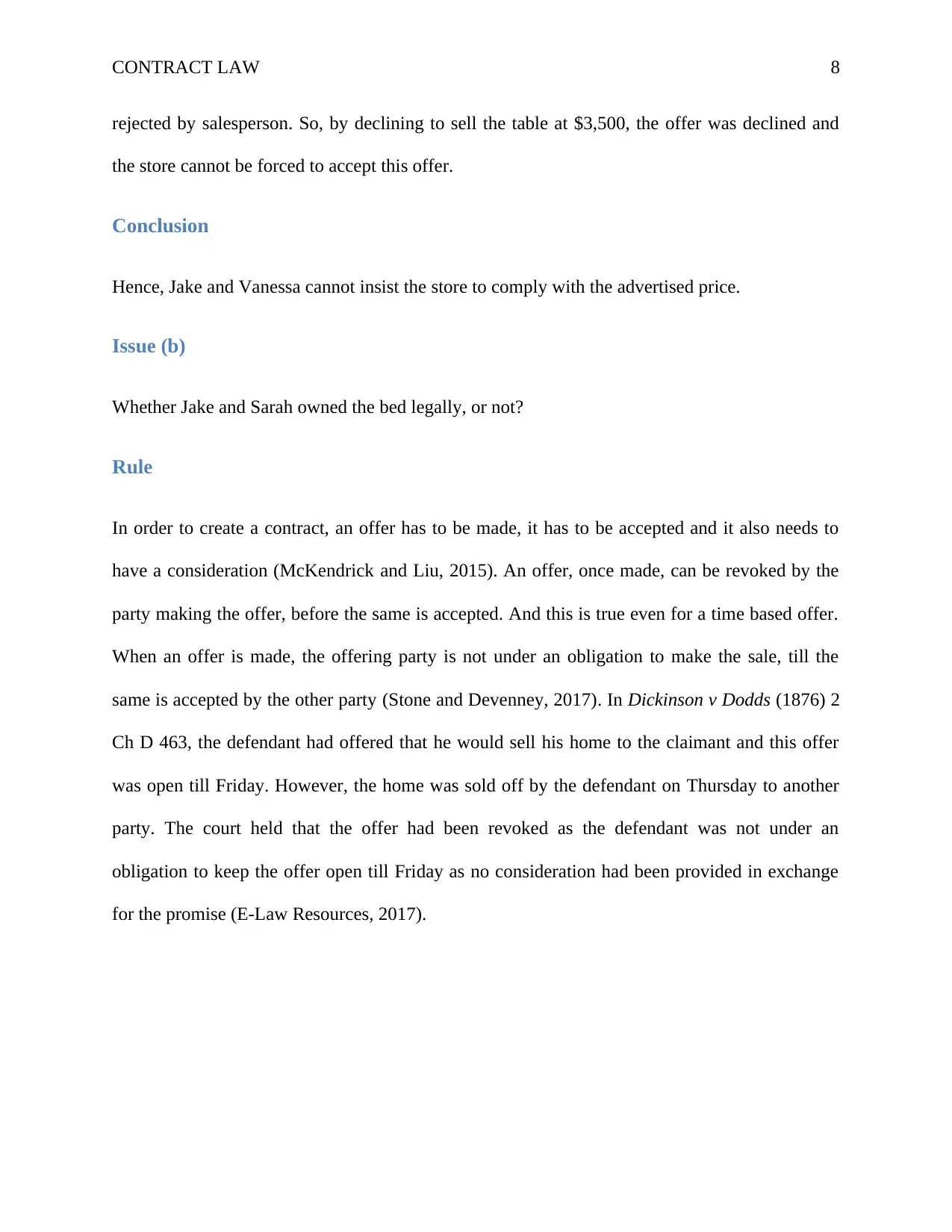
CONTRACT LAW 8
rejected by salesperson. So, by declining to sell the table at $3,500, the offer was declined and
the store cannot be forced to accept this offer.
Conclusion
Hence, Jake and Vanessa cannot insist the store to comply with the advertised price.
Issue (b)
Whether Jake and Sarah owned the bed legally, or not?
Rule
In order to create a contract, an offer has to be made, it has to be accepted and it also needs to
have a consideration (McKendrick and Liu, 2015). An offer, once made, can be revoked by the
party making the offer, before the same is accepted. And this is true even for a time based offer.
When an offer is made, the offering party is not under an obligation to make the sale, till the
same is accepted by the other party (Stone and Devenney, 2017). In Dickinson v Dodds (1876) 2
Ch D 463, the defendant had offered that he would sell his home to the claimant and this offer
was open till Friday. However, the home was sold off by the defendant on Thursday to another
party. The court held that the offer had been revoked as the defendant was not under an
obligation to keep the offer open till Friday as no consideration had been provided in exchange
for the promise (E-Law Resources, 2017).
rejected by salesperson. So, by declining to sell the table at $3,500, the offer was declined and
the store cannot be forced to accept this offer.
Conclusion
Hence, Jake and Vanessa cannot insist the store to comply with the advertised price.
Issue (b)
Whether Jake and Sarah owned the bed legally, or not?
Rule
In order to create a contract, an offer has to be made, it has to be accepted and it also needs to
have a consideration (McKendrick and Liu, 2015). An offer, once made, can be revoked by the
party making the offer, before the same is accepted. And this is true even for a time based offer.
When an offer is made, the offering party is not under an obligation to make the sale, till the
same is accepted by the other party (Stone and Devenney, 2017). In Dickinson v Dodds (1876) 2
Ch D 463, the defendant had offered that he would sell his home to the claimant and this offer
was open till Friday. However, the home was sold off by the defendant on Thursday to another
party. The court held that the offer had been revoked as the defendant was not under an
obligation to keep the offer open till Friday as no consideration had been provided in exchange
for the promise (E-Law Resources, 2017).
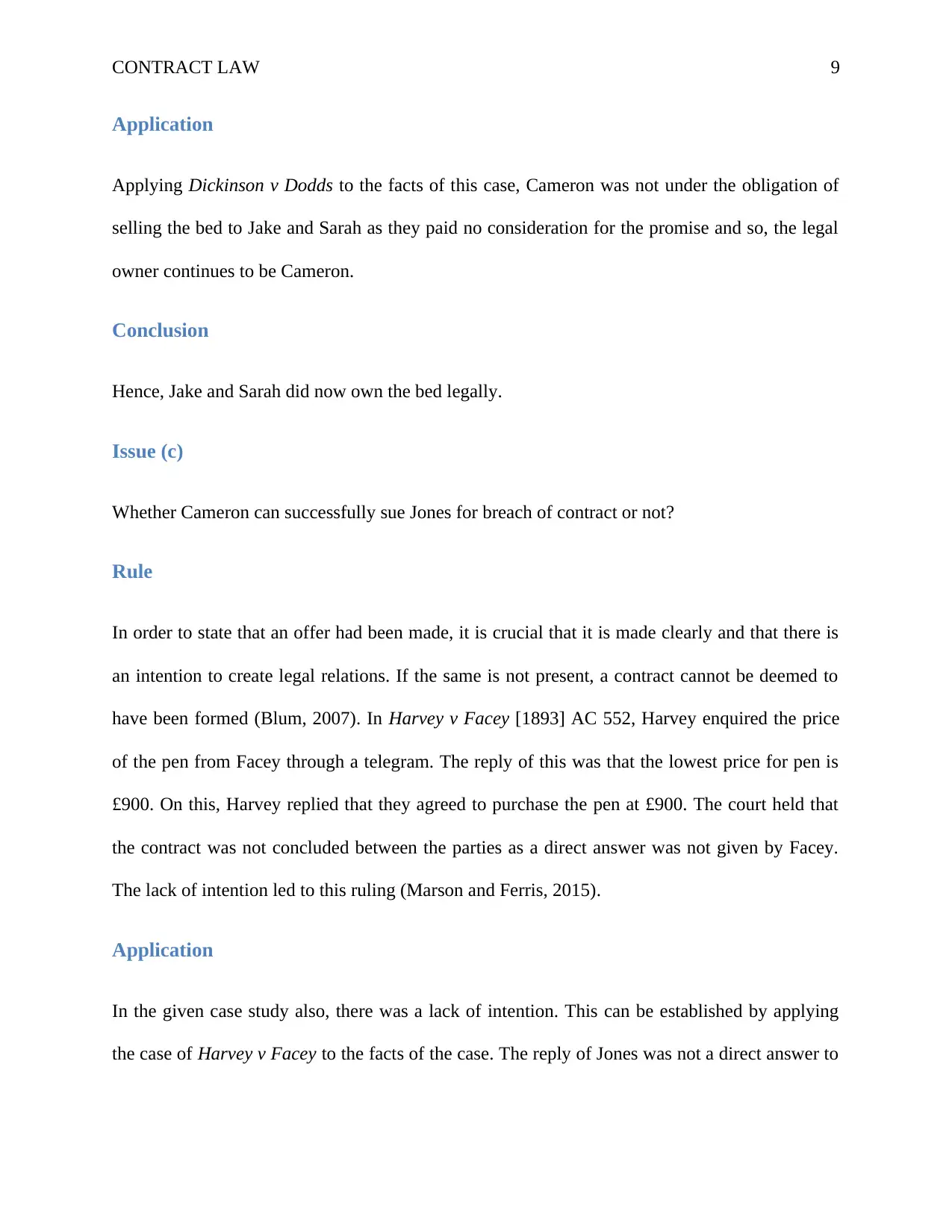
CONTRACT LAW 9
Application
Applying Dickinson v Dodds to the facts of this case, Cameron was not under the obligation of
selling the bed to Jake and Sarah as they paid no consideration for the promise and so, the legal
owner continues to be Cameron.
Conclusion
Hence, Jake and Sarah did now own the bed legally.
Issue (c)
Whether Cameron can successfully sue Jones for breach of contract or not?
Rule
In order to state that an offer had been made, it is crucial that it is made clearly and that there is
an intention to create legal relations. If the same is not present, a contract cannot be deemed to
have been formed (Blum, 2007). In Harvey v Facey [1893] AC 552, Harvey enquired the price
of the pen from Facey through a telegram. The reply of this was that the lowest price for pen is
£900. On this, Harvey replied that they agreed to purchase the pen at £900. The court held that
the contract was not concluded between the parties as a direct answer was not given by Facey.
The lack of intention led to this ruling (Marson and Ferris, 2015).
Application
In the given case study also, there was a lack of intention. This can be established by applying
the case of Harvey v Facey to the facts of the case. The reply of Jones was not a direct answer to
Application
Applying Dickinson v Dodds to the facts of this case, Cameron was not under the obligation of
selling the bed to Jake and Sarah as they paid no consideration for the promise and so, the legal
owner continues to be Cameron.
Conclusion
Hence, Jake and Sarah did now own the bed legally.
Issue (c)
Whether Cameron can successfully sue Jones for breach of contract or not?
Rule
In order to state that an offer had been made, it is crucial that it is made clearly and that there is
an intention to create legal relations. If the same is not present, a contract cannot be deemed to
have been formed (Blum, 2007). In Harvey v Facey [1893] AC 552, Harvey enquired the price
of the pen from Facey through a telegram. The reply of this was that the lowest price for pen is
£900. On this, Harvey replied that they agreed to purchase the pen at £900. The court held that
the contract was not concluded between the parties as a direct answer was not given by Facey.
The lack of intention led to this ruling (Marson and Ferris, 2015).
Application
In the given case study also, there was a lack of intention. This can be established by applying
the case of Harvey v Facey to the facts of the case. The reply of Jones was not a direct answer to
⊘ This is a preview!⊘
Do you want full access?
Subscribe today to unlock all pages.

Trusted by 1+ million students worldwide
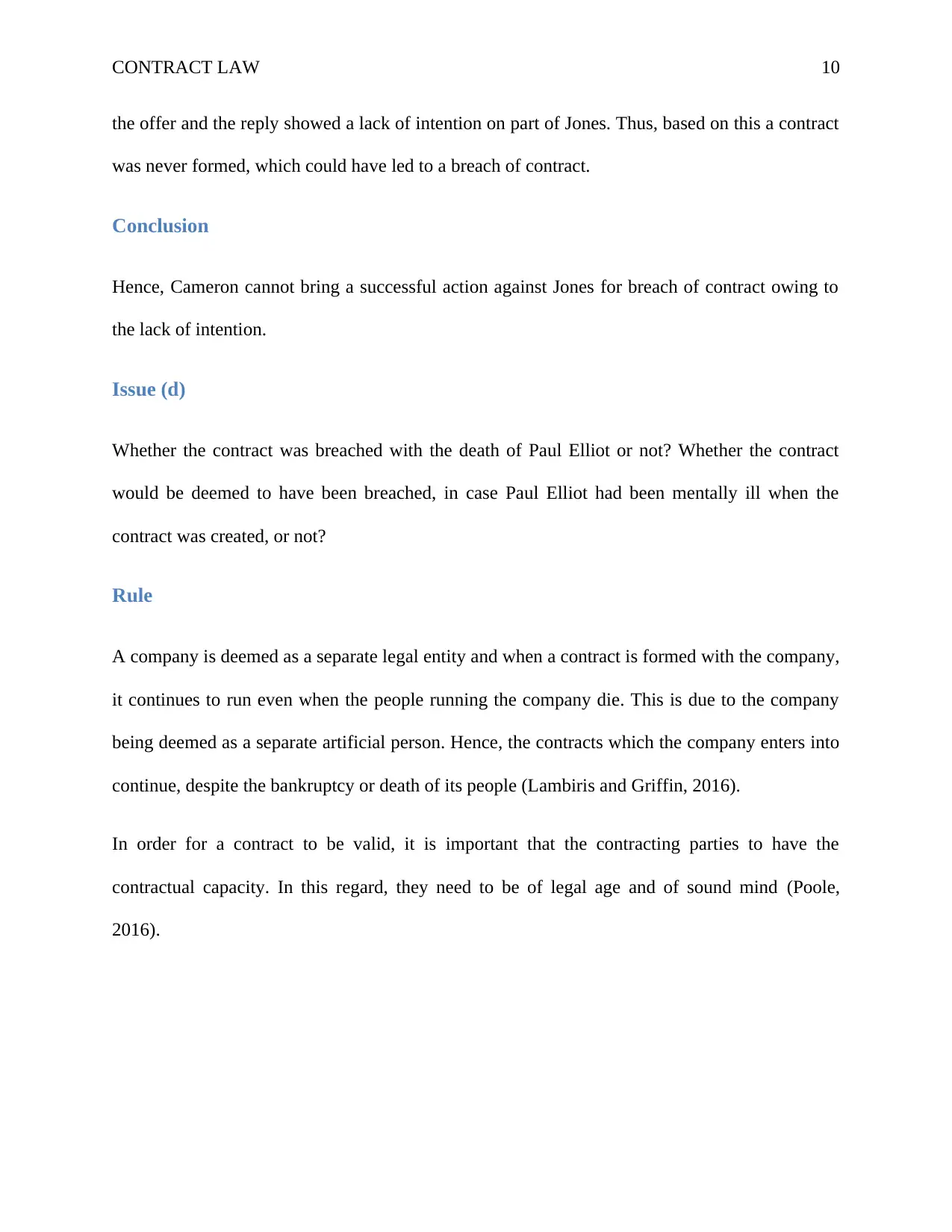
CONTRACT LAW 10
the offer and the reply showed a lack of intention on part of Jones. Thus, based on this a contract
was never formed, which could have led to a breach of contract.
Conclusion
Hence, Cameron cannot bring a successful action against Jones for breach of contract owing to
the lack of intention.
Issue (d)
Whether the contract was breached with the death of Paul Elliot or not? Whether the contract
would be deemed to have been breached, in case Paul Elliot had been mentally ill when the
contract was created, or not?
Rule
A company is deemed as a separate legal entity and when a contract is formed with the company,
it continues to run even when the people running the company die. This is due to the company
being deemed as a separate artificial person. Hence, the contracts which the company enters into
continue, despite the bankruptcy or death of its people (Lambiris and Griffin, 2016).
In order for a contract to be valid, it is important that the contracting parties to have the
contractual capacity. In this regard, they need to be of legal age and of sound mind (Poole,
2016).
the offer and the reply showed a lack of intention on part of Jones. Thus, based on this a contract
was never formed, which could have led to a breach of contract.
Conclusion
Hence, Cameron cannot bring a successful action against Jones for breach of contract owing to
the lack of intention.
Issue (d)
Whether the contract was breached with the death of Paul Elliot or not? Whether the contract
would be deemed to have been breached, in case Paul Elliot had been mentally ill when the
contract was created, or not?
Rule
A company is deemed as a separate legal entity and when a contract is formed with the company,
it continues to run even when the people running the company die. This is due to the company
being deemed as a separate artificial person. Hence, the contracts which the company enters into
continue, despite the bankruptcy or death of its people (Lambiris and Griffin, 2016).
In order for a contract to be valid, it is important that the contracting parties to have the
contractual capacity. In this regard, they need to be of legal age and of sound mind (Poole,
2016).
Paraphrase This Document
Need a fresh take? Get an instant paraphrase of this document with our AI Paraphraser
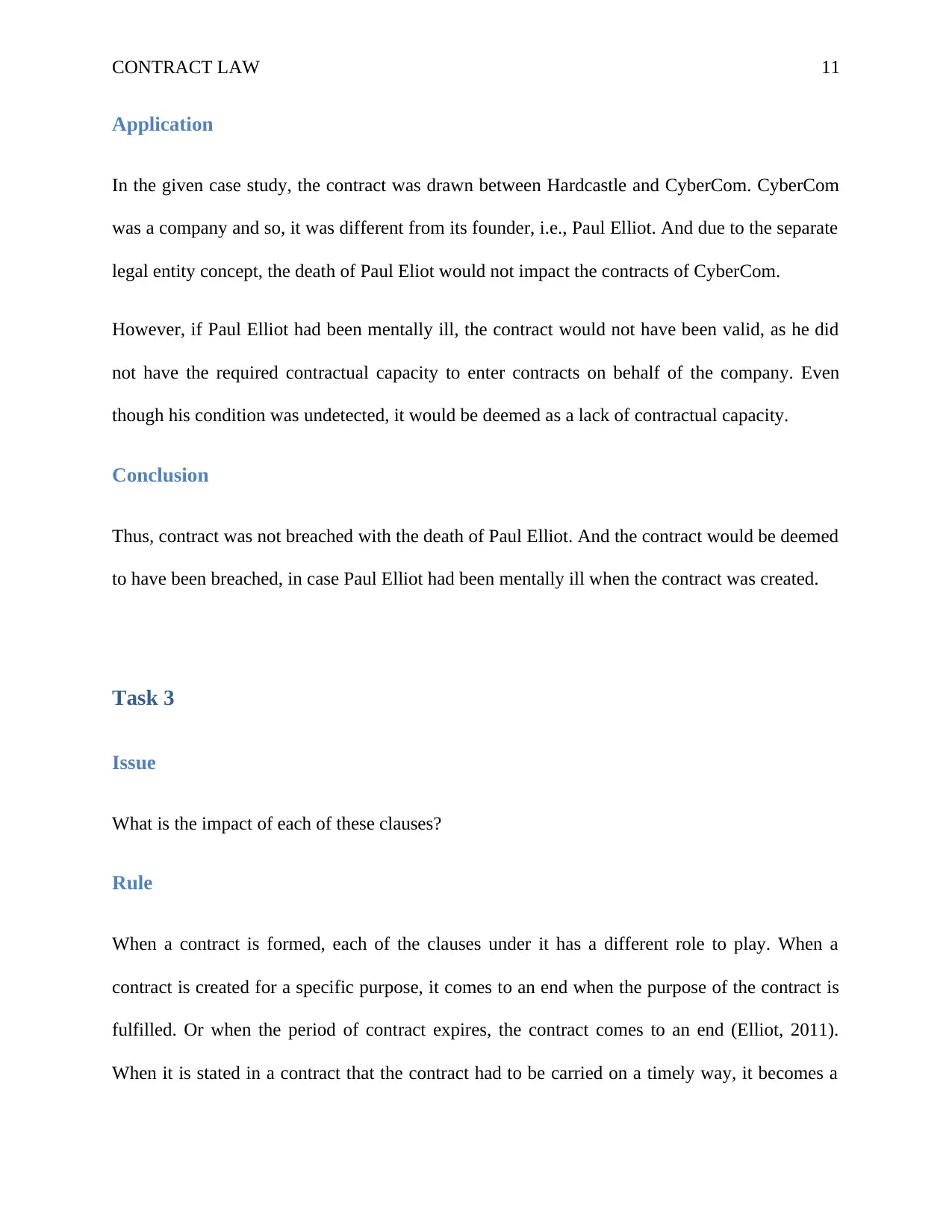
CONTRACT LAW 11
Application
In the given case study, the contract was drawn between Hardcastle and CyberCom. CyberCom
was a company and so, it was different from its founder, i.e., Paul Elliot. And due to the separate
legal entity concept, the death of Paul Eliot would not impact the contracts of CyberCom.
However, if Paul Elliot had been mentally ill, the contract would not have been valid, as he did
not have the required contractual capacity to enter contracts on behalf of the company. Even
though his condition was undetected, it would be deemed as a lack of contractual capacity.
Conclusion
Thus, contract was not breached with the death of Paul Elliot. And the contract would be deemed
to have been breached, in case Paul Elliot had been mentally ill when the contract was created.
Task 3
Issue
What is the impact of each of these clauses?
Rule
When a contract is formed, each of the clauses under it has a different role to play. When a
contract is created for a specific purpose, it comes to an end when the purpose of the contract is
fulfilled. Or when the period of contract expires, the contract comes to an end (Elliot, 2011).
When it is stated in a contract that the contract had to be carried on a timely way, it becomes a
Application
In the given case study, the contract was drawn between Hardcastle and CyberCom. CyberCom
was a company and so, it was different from its founder, i.e., Paul Elliot. And due to the separate
legal entity concept, the death of Paul Eliot would not impact the contracts of CyberCom.
However, if Paul Elliot had been mentally ill, the contract would not have been valid, as he did
not have the required contractual capacity to enter contracts on behalf of the company. Even
though his condition was undetected, it would be deemed as a lack of contractual capacity.
Conclusion
Thus, contract was not breached with the death of Paul Elliot. And the contract would be deemed
to have been breached, in case Paul Elliot had been mentally ill when the contract was created.
Task 3
Issue
What is the impact of each of these clauses?
Rule
When a contract is formed, each of the clauses under it has a different role to play. When a
contract is created for a specific purpose, it comes to an end when the purpose of the contract is
fulfilled. Or when the period of contract expires, the contract comes to an end (Elliot, 2011).
When it is stated in a contract that the contract had to be carried on a timely way, it becomes a

CONTRACT LAW 12
contractual term and has to be fulfilled properly. When the contractual terms are not fulfilled, a
breach of contract takes place (Ayres and Klass, 2012). The contractual terms have to be clear
and cannot be ambiguous. And the clarity of contractual terms is deemed as one of the essential
elements of creating a contract (Andrews, 2015).
In a contract, a condition is considered as a very important element and is deemed as a crucial
foundation of the contract. Where a condition set under the contract is not upheld, the aggrieved
party can repudiate the contract and claim damages from the other party (McKendrick, 2014).
Poussard v Spiers and Pond [1876] 1 QBD 410 was a case in which the court was of the view
that owing to the contravention of the condition, the breach of contract took place. This shows
that condition of a contract is a vital element and same has to be properly adhered, or else it
could allow the non breaching party to make a case of breach against the breaching party
(Latimer, 2012).
An exclusion clause is such a clause in a contract through which the liabilities of parties is
restricted for a breach of contract or for any other matter. In order for an exclusion clause to be
valid, it is important that the same is properly included in the contract. Also, it has to be properly
brought to the attention of the other party against which the same would apply. Apart from this,
an exclusion clause cannot restrict the applicability of a statutory or a common law and where it
does so, it would not be a valid exclusion clause (Mulcahy, 2008).
Where the exclusion clause is contained within the contract, it is considered as a properly
inserted and a valid exclusion clause, particularly where the contract is signed by the parties of
the contract (Paterson, Robertson and Duke, 2012). In L'Estrange v Graucob [1934] 2 KB 394, it
was held by the court that as the exclusion clause had been signed by the parties, the same would
contractual term and has to be fulfilled properly. When the contractual terms are not fulfilled, a
breach of contract takes place (Ayres and Klass, 2012). The contractual terms have to be clear
and cannot be ambiguous. And the clarity of contractual terms is deemed as one of the essential
elements of creating a contract (Andrews, 2015).
In a contract, a condition is considered as a very important element and is deemed as a crucial
foundation of the contract. Where a condition set under the contract is not upheld, the aggrieved
party can repudiate the contract and claim damages from the other party (McKendrick, 2014).
Poussard v Spiers and Pond [1876] 1 QBD 410 was a case in which the court was of the view
that owing to the contravention of the condition, the breach of contract took place. This shows
that condition of a contract is a vital element and same has to be properly adhered, or else it
could allow the non breaching party to make a case of breach against the breaching party
(Latimer, 2012).
An exclusion clause is such a clause in a contract through which the liabilities of parties is
restricted for a breach of contract or for any other matter. In order for an exclusion clause to be
valid, it is important that the same is properly included in the contract. Also, it has to be properly
brought to the attention of the other party against which the same would apply. Apart from this,
an exclusion clause cannot restrict the applicability of a statutory or a common law and where it
does so, it would not be a valid exclusion clause (Mulcahy, 2008).
Where the exclusion clause is contained within the contract, it is considered as a properly
inserted and a valid exclusion clause, particularly where the contract is signed by the parties of
the contract (Paterson, Robertson and Duke, 2012). In L'Estrange v Graucob [1934] 2 KB 394, it
was held by the court that as the exclusion clause had been signed by the parties, the same would
⊘ This is a preview!⊘
Do you want full access?
Subscribe today to unlock all pages.

Trusted by 1+ million students worldwide
1 out of 16
Related Documents
Your All-in-One AI-Powered Toolkit for Academic Success.
+13062052269
info@desklib.com
Available 24*7 on WhatsApp / Email
![[object Object]](/_next/static/media/star-bottom.7253800d.svg)
Unlock your academic potential
Copyright © 2020–2025 A2Z Services. All Rights Reserved. Developed and managed by ZUCOL.





